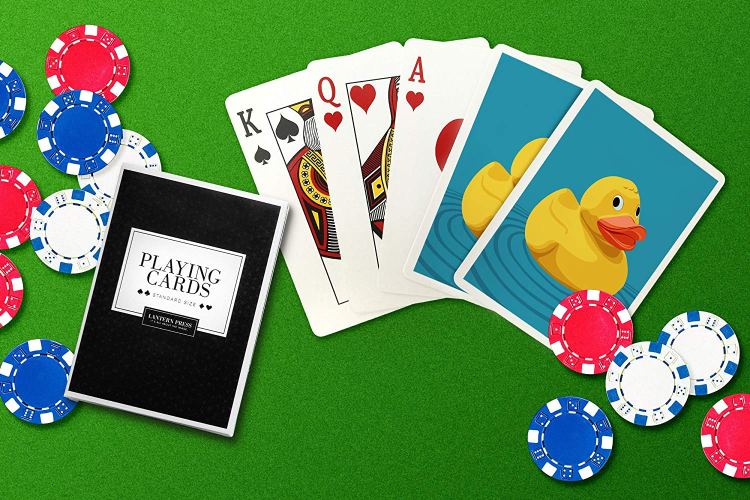Just because it looks like a duck, walks like a duck, and talks like a duck doesn’t mean it is a duck. In this series of articles we looks at some of the poker-like games you’ll encounter at casinos that are not poker.
But It Ain’t Poker

But It Ain’t Poker
When you read the information on the Web sites of many brick-and-mortar (those with a physical presence, as opposed to online) casinos, you may think they have poker. If you call the toll-free numbers of some and ask, you will be assured that, yes, they do. If it’s a casino outside the US, there may be no toll-free number, but you’ll find among their lists of games many that look like poker or else the simple term “poker” among the games.
But just because it looks like a duck, walks like a duck, and talks like a duck doesn’t mean it is a duck.
This and subsequent columns present some of the poker-like games you’ll encounter that are not poker. The main resemblance they have to poker is the hand rankings. What makes them not poker is that players don’t bet against each other nor is there real bluffing.
Casino poker:
1. Poker as played in a cardroom within a casino. 2. Any of several house-dealt games in which players compete against the dealer to either beat the dealer’s hand or to make certain hands, which pay off according to pay tables. These games are not like “traditional” poker in which players compete against each other, and are “poker” only in that poker comes into play solely for the purpose of ranking hands. These games have a fixed house edge and involve little, if any, skill, since players make their bets before receiving their cards. Although in some of the games players can make further wagers after seeing their cards, they are not playing against each other and betting to build pots or to bluff others out are not part of the games.
The first definition fits the “real” poker games, games such as hold’em, Omaha, seven-card stud, and other variants wherein players sit at a table and are dealt cards, usually by a house dealer. The following games fit the second definition.
Arizona hold’em poker:
A house-banked game dealt from one deck, in which players play separately against the dealer. The game is related to hold’em in the way hands are formed, but is not really a poker game. It is also very similar to Let It Ride Bonus. Each player has three betting areas marked A, 1, and 2. Each player makes an ante bet in betting area A. Each player receives three cards face down, and two cards are dealt face down as community cards, which will be used by each player to make a five-card hand. Players then look at their cards. Each player decides in turn to continue betting, or stop at just the ante bet. To continue, a player places a bet equal to the ante bet in area 1. The first community card is then turned over. Again each player who has made another bet decides in turn to continue betting, or stop where he is. To continue, a player places a bet equal to the ante bet in area 2. At this point, each player has made one, two, or three bets. The second community card is then turned over. The dealer reveals each hand in turn. If the player does not have a pair of 10s or higher, he loses all bets. Winning payouts are: royal flush, 250:1; straight flush, 50:1; four of a kind, 25:1; full house, 12:1; flush, 10:1; straight, 8:1; three of a kind, 3:1; two pair, 2:1; pair of 10s through aces, 1:1.
Big Raise Hold’em:
A house-banked game dealt from one deck, in which players play separately against the dealer. The game is related to hold’em in the way hands are formed, but is not really a poker game. Each player makes an ante bet and can also make a Big Raise bet of from one to three times the ante. This is done before receiving any cards.
A further bet can be made to play against the bonus pay table; this bet wins when the player’s final hand is a pair of eights or better. Each player receives two hole cards and the dealer receives three cards — two face down and one face up. If the dealer’s upcard is an ace or a king, the player must go “all in,” risking both the ante and Big Raise. Otherwise, the player has a choice: risk the ante or the Big Raise bet (but not both), unless he has a pair, in which case he can risk both (go all in).
After bets have been placed, the dealer then reveals their starting hand and deals three community cards, which then combine with the player’s hole cards to form the player’s five-card hand, and with the dealer’s three (if he started with an ace or king) or two hole cards to form the dealer’s best five-card hand.
If the player’s hand beats the dealer’s, the player wins even money on the bet left in action, with ties pushing. Certain hands win payouts for the bonus bet, ranging from even money for a pair of eights to 50:1 for a royal flush. In addition, the ante and Big Raise bets always win 50:1 for a royal flush and 40:1 for a straight flush (in addition to the bonus payout). The game was invented by Shuffle Master, a company that makes automatic card-shuffling machines for casinos and cardrooms and devises new casino games.
Watch for Part Two of It Ain’t Poker coming soon –








